Returning Solar Panel Production To US Speeds Decarbonization
Domestic production of solar panels – most of which are now made in Asia – can speed up decarbonization in the U.S., according to new Cornell University research published in Nature Communications.
The scientists found that if solar panel manufacturing can return to the U.S. by 2035, the greenhouse gas emissions resulting from panel creation would be reduced by 30% and energy consumption would be cut by 13%, compared to 2020, when the U.S. relied almost entirely on international trading partners.
Manufacturing crystalline silicon photovoltaic panels in the U.S. solves logistical challenges and eases greenhouse gas problems, according to the paper.
By 2050, the solar panels made and used in the U.S. will be more efficient, and will reduce the carbon footprint by 33% and use 17% less energy than solar panels sourced globally in 2020.
The climate-change mitigation forecast would be fulfilled by both reshoring the solar panel manufacturing back to the U.S. and having mostly renewable energy on the power grid, which is anticipated in the next decades.
Based on projections about the energy decarbonization transition that happens alongside reshoring, the U.S. will see a larger share of renewable power accounting for primary energy consumption and an overall lower primary energy consumption over the years for solar panel manufacturing, according to Fengqi You, senior author and professor in energy systems engineering.
The federal Inflation Reduction Act – signed into law in August 2022 – provides $369 billion in business incentives and tax credits to build a clean energy economy, according to the White House. In addition to wind turbines and grid-scale battery plants, the act provides for the production of than 950 million solar panels.
In 2022, about 4.24 trillion kilowatt hours of electricity were generated domestically at utility-scale plants in the United States, according to the U.S. Energy Information Administration. About 22% of that electricity came from renewable energy sources, but only 3.4% was generated from solar power.
“By 2050, around half of U.S. electricity will come from solar energy. Now, we only have about 3%,” You said. “The U.S. is ramping up. We are going to increase solar capacity from 74 gigawatts in 2022 to a projected 1,600 gigwatts by 2050. That means we will need a lot more panels in the next three decades.”
The new paper creates reasonable predictions for scenarios that involve a U.S.-centered domestic supply of panels, which could lead to a competitive supply chain of solar panel module components production in regions like Alabama, Florida and Georgia.
“When you consider the solar panel industry will grow by a factor of over 10 until mid-century, those greenhouse gas emission savings could be quite significant,” said You, who is also a senior faculty fellow at Cornell Atkinson Center for Sustainability.

